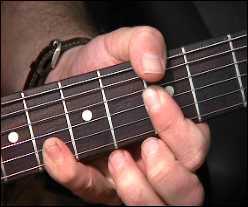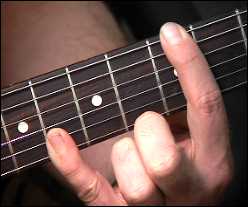Scroll through the lesson and click on notation/video/audio links to load the interactive players.
Please subscribe to get full access to all lessons for only $7.95/month PLUS 1 week free trial.

Riff Interactive lessons are
LESS expensive and
MORE interactive than alternatives!
More Info
|
|
| Lesson Subject:
Stevie Ray Vaughan Style |
| What you learn:
Runs & Licks |
| Michael: Michael Johnson |
Michael: Welcome class! This interactive
lesson will focus on classic runs/licks of Stevie Ray Vaughan. Technically
speaking a "run" can also be referred to as a "sequence", meaning a mathematical
sequence of notes that ascends or descends a scale. Music can have a definite
sequence of notes much in the way we practice scales and exercises, but Stevie
had the incredible ability for blending blues licks, scales, sequences, whatever
to form an extended phrase that can only be described as musical. These extended
musical phrases are what we're going to cover in this lesson and essential to
helping you develop your solos to the next level! Check out the lesson sample of
what you will learn in this lesson:
Lesson Sample - Highband - 1.6 Meg
Michael: We will continue to use the same rhythm
and jam track form the previous lesson.
We will continue to use a I, IV, V progression in E. Here's the jam
track.
Looping Jam
Track - Lowband
Michael:
For part 1 you will learn licks in the E Minor Blues scale in the open
position. Here's the E Minor Blues scale pattern:
E Minor
Blues
Michael:
Here's the first lick in this pattern:
Part 1 - Lick 1
Part 1 - Lick
1
Michael:
This first lick starts off with a slide from the 3rd to 5th frets/2nd string
while the open 1st string rings open as a pedal tone. Next the lick descends the
scale pattern in the open position. After the lick reaches the lower strings,
you ascend the scale pattern, which includes a b5 and later a Major 7 note,
which is highlighted in the notation.
Michael: Here's the E Minor Blues with the Major
7 notes added.
E
Minor Blues (Maj 7)
Michael:
Remember this pattern, you will learn more licks using this combination of
notes. Here's the next lick.
Part 1 - Lick 2
Part 1 - Lick
2
Michael:
This lick uses an interesting combination. Notice how you ascend the scale
pattern using the E Minor Blues and include the Major 7 note. Bar 2 uses a
hammer/pull-off combination between the 4th (A) and b5 (Bb) notes. SRV uses this
combination of notes often when playing in the open E position of the
neck. Here's the next lick:
Part 1 - Lick 3
Part 1 - Lick
3
Michael:
This lick has a unique sound. The lick starts off with a slide to the Major 7
note on the 4th fret/2nd string. Notice in bar the the hammer/pull-off
combination to the b5 note (3rd fret/3rd string) as well. Bar 3 ends with
the hammer/pull-off the the 4th and b5 note again. Here's the next
lick.
Part 1 -
Lick 4
Part 1 - Lick
4
Michael:
Notice all the variations you can play using the same note combination. This
variation starts with a slide to the b5, then playing the open notes on the 2nd
and 1st strings. The lick gradually works it way down using various
hammer/pull-off combination using the Major 7 and b5 notes. OK, in this next
section you will learn a few licks the use the minor blues and Major 7 notes,
but this time you will use movable scale patterns that follow the I, IV, V
progression in E. Here's the first lick.
Part 2 - Lick 1 (E)
Part 2 - Lick
1
Michael:
This is a cool sounding lick! You start by playing the E root note on the open
6th string, then the b7 and 9th notes on the 3rd fret/1st & 2nd
strings. Next you have a double-stop hammer-on to the Major 3rd
note. Bars 2 & 3 use some of the same licks you learned earlier, using
the b5 and Major 7 notes.
Michael: Now, this pattern can move to the A
position on the 5th fret while playing over the IV of the progression. This
technique is called a "movable scale" pattern.
Part 2 -
Lick 2 (A)
Part 2 - Lick
2
Michael:
OK, this is the same basic lick, however you will have to adjust your fingering
to play this lick. In this example I use the thumb to bar the 5th fret/6th
string, while using the other fingers to play the licks on the higher string.
Stevie used his thumb often to play licks like these, as well as Jimi Hendrix
and other blues guitarists. Here is a picture of my hand
position.
A9 - With
Thumb

Michael: Notice how the 4th finger frets the b7
and 9 notes on the 1st and 2nd strings. The 1st finger also barres the 5th fret
to play any notes used in that position. Some of you might have a tough time
using your thumb, so you can substitute using the 1st finger barred on the 5th
fret as well.
A9 -
No Thumb

Michael: Now you can move this lick combination
to the 7th fret t play over the V (B) of the progression. Here's the
licks.
Part 2 -
Lick 3 (B)
Part 2 - Lick
3
Michael:
Notice that this is the same lick as the previous one, but this time it's based
on the 7th fret. For the next section of the lesson you will learn a few
turnarounds. A "turnaround" is typically a musical phrase that plays over the
ending or even beginning of a blues progression. These types of licks are
essential to any musician playing the blues. The turnaround is typically played
over the last chord of the progression. In this case we'll use the key of E.
Here's the first turnaround.
Part
3 - Lick 1
Part 3 - Lick
1
Michael: This
turnaround starts by using double-stop notes. The notes used are a b7 and #9.
This combo creates a sound of tension. Notice the towards the end of the
lick you ascend the pattern using the b5 and Major 7 note. Here's another
turnaround.
Part 3
- Lick 2
Part 3 - Lick
2
Michael:
This version basically uses the same licks from the previous turnaround, but in
this example you jump the double-stop up to the 6th and 7th frets/1st and 2nd
string. The ending is different as well, playing a C9, and then B9 chord to end
the turnaround. You can also play this turnaround on the octave portion of the
neck as well. Here's the octave
turnaround.
Part 3
- Lick 3
Part 3 - Lick
3
Michael:
Notice the same lick is played, but this time you have to use the 1st finger to
barre notes on the 12th fret.
Michael: Well it's time to go, any
questions?
Doug:
nope Thanks
tom:
I'll work on this more
Michael: Well practice this week and I hope to
see you at the next lesson!
hank: many thanks!!
|
<< load notation from left
|
|
<< load audio from left
|
<< load audio from left
|